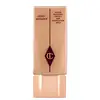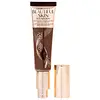What's inside
What's inside
 Key Ingredients
Key Ingredients

 Benefits
Benefits

 Concerns
Concerns

 Ingredients Side-by-side
Ingredients Side-by-side

Cyclopentasiloxane
EmollientWater
Skin ConditioningHydrogenated Didodecene
Ethylhexyl Methoxycinnamate
UV AbsorberMica
Cosmetic ColorantGlycerin
HumectantSorbitan Isostearate
EmulsifyingTitanium Dioxide
Cosmetic ColorantPEG/PPG-18/18 Dimethicone
EmulsifyingSodium Chloride
MaskingCyclohexasiloxane
EmollientAluminum/Magnesium Hydroxide Stearate
Emulsion StabilisingDimethicone/Vinyl Dimethicone Crosspolymer
Skin ConditioningCetearyl Ethylhexanoate
EmollientSqualane
EmollientDimethicone
EmollientDisodium Cocoyl Glutamate
CleansingMethylparaben
PreservativePotassium Sorbate
PreservativeIsopropyl Titanium Triisostearate
EmollientPropylparaben
PreservativeSilica
AbrasiveParfum
MaskingSodium Cocoyl Glutamate
CleansingAluminum Hydroxide
EmollientLaureth-4
EmulsifyingPentaerythrityl Tetra-Di-T-Butyl Hydroxyhydrocinnamate
AntioxidantBHT
AntioxidantCI 77891
Cosmetic ColorantIron Oxides
Cyclopentasiloxane, Water, Hydrogenated Didodecene, Ethylhexyl Methoxycinnamate, Mica, Glycerin, Sorbitan Isostearate, Titanium Dioxide, PEG/PPG-18/18 Dimethicone, Sodium Chloride, Cyclohexasiloxane, Aluminum/Magnesium Hydroxide Stearate, Dimethicone/Vinyl Dimethicone Crosspolymer, Cetearyl Ethylhexanoate, Squalane, Dimethicone, Disodium Cocoyl Glutamate, Methylparaben, Potassium Sorbate, Isopropyl Titanium Triisostearate, Propylparaben, Silica, Parfum, Sodium Cocoyl Glutamate, Aluminum Hydroxide, Laureth-4, Pentaerythrityl Tetra-Di-T-Butyl Hydroxyhydrocinnamate, BHT, CI 77891, Iron Oxides
Water
Skin ConditioningPyrus Malus Fruit Water
MaskingDimethicone
EmollientMica
Cosmetic ColorantOctyldodecyl Stearoyl Stearate
EmollientCetyl PEG/PPG-10/1 Dimethicone
EmulsifyingHydrogenated Ethylhexyl Olivate
EmollientHydrogenated Polyisobutene
EmollientPropanediol
SolventGlycerin
HumectantTrimethylsiloxysilicate
EmollientPolyglyceryl-4 Isostearate
EmulsifyingSodium Chloride
MaskingLauroyl Lysine
Skin ConditioningDimethicone/Vinyl Dimethicone Crosspolymer
Skin ConditioningDisteardimonium Hectorite
StabilisingSodium Dehydroacetate
PreservativeHydrogenated Olive Oil Unsaponifiables
EmollientCaprylyl Glycol
Emollient1,2-Hexanediol
Skin ConditioningTriethoxycaprylylsilane
Sodium Gluconate
Skin ConditioningTocopheryl Acetate
AntioxidantMaltodextrin
AbsorbentBixa Orellana Seed Extract
MaskingPentylene Glycol
Skin ConditioningButylene Glycol
HumectantCassia Angustifolia Seed Polysaccharide
Skin ConditioningSodium Hyaluronate
HumectantCocos Nucifera Fruit Extract
EmollientAluminum Hydroxide
EmollientRosa Damascena Flower Oil
MaskingRosa Damascena Flower Water
MaskingPentaerythrityl Tetra-Di-T-Butyl Hydroxyhydrocinnamate
AntioxidantCI 77891
Cosmetic ColorantIron Oxides
Water, Pyrus Malus Fruit Water, Dimethicone, Mica, Octyldodecyl Stearoyl Stearate, Cetyl PEG/PPG-10/1 Dimethicone, Hydrogenated Ethylhexyl Olivate, Hydrogenated Polyisobutene, Propanediol, Glycerin, Trimethylsiloxysilicate, Polyglyceryl-4 Isostearate, Sodium Chloride, Lauroyl Lysine, Dimethicone/Vinyl Dimethicone Crosspolymer, Disteardimonium Hectorite, Sodium Dehydroacetate, Hydrogenated Olive Oil Unsaponifiables, Caprylyl Glycol, 1,2-Hexanediol, Triethoxycaprylylsilane, Sodium Gluconate, Tocopheryl Acetate, Maltodextrin, Bixa Orellana Seed Extract, Pentylene Glycol, Butylene Glycol, Cassia Angustifolia Seed Polysaccharide, Sodium Hyaluronate, Cocos Nucifera Fruit Extract, Aluminum Hydroxide, Rosa Damascena Flower Oil, Rosa Damascena Flower Water, Pentaerythrityl Tetra-Di-T-Butyl Hydroxyhydrocinnamate, CI 77891, Iron Oxides
Ingredients Explained
These ingredients are found in both products.
Ingredients higher up in an ingredient list are typically present in a larger amount.
Aluminum Hydroxide is a form of aluminum. It can be naturally found in nature as the mineral gibbsite. In cosmetics, Aluminum Hydroxide is used as a colorant, pH adjuster, and absorbent.
As a colorant, Aluminum Hydroxide may add opacity, or reduce the transparency. Aluminum hydroxide is contains both basic and acidic properties.
According to manufacturers, this ingredient is an emollient and humectant. This means it helps hydrate the skin.
In medicine, this ingredient is used to help relieve heartburn and help heal ulcers.
There is currently no credible scientific evidence linking aluminum hydroxide in cosmetics to increased cancer risk.
Major health organizations allow the use of aluminum hydroxide in personal care products and have not flagged it as a carcinogenic risk at typical usage levels.
Learn more about Aluminum HydroxideCi 77891 is a white pigment from Titanium dioxide. It is naturally found in minerals such as rutile and ilmenite.
It's main function is to add a white color to cosmetics. It can also be mixed with other colors to create different shades.
Ci 77891 is commonly found in sunscreens due to its ability to block UV rays.
Learn more about CI 77891Dimethicone is a type of synthetic silicone created from natural materials such as quartz.
What it does:
Dimethicone comes in different viscosities:
Depending on the viscosity, dimethicone has different properties.
Ingredients lists don't always show which type is used, so we recommend reaching out to the brand if you have questions about the viscosity.
This ingredient is unlikely to cause irritation because it does not get absorbed into skin. However, people with silicone allergies should be careful about using this ingredient.
Note: Dimethicone may contribute to pilling. This is because it is not oil or water soluble, so pilling may occur when layered with products. When mixed with heavy oils in a formula, the outcome is also quite greasy.
Learn more about DimethiconeThis ingredient is a silicone used to improve the texture of products and absorb oil. It does not get absorbed into the skin.
Like other silicones, Dimethicone/Vinyl Dimethicone Crosspolymer helps condition the skin by creating a barrier. In this sense, it can act as an emollient and trap moisture in.
This ingredient is a type of elastomer.
Learn more about Dimethicone/Vinyl Dimethicone CrosspolymerGlycerin is already naturally found in your skin. It helps moisturize and protect your skin.
A study from 2016 found glycerin to be more effective as a humectant than AHAs and hyaluronic acid.
As a humectant, it helps the skin stay hydrated by pulling moisture to your skin. The low molecular weight of glycerin allows it to pull moisture into the deeper layers of your skin.
Hydrated skin improves your skin barrier; Your skin barrier helps protect against irritants and bacteria.
Glycerin has also been found to have antimicrobial and antiviral properties. Due to these properties, glycerin is often used in wound and burn treatments.
In cosmetics, glycerin is usually derived from plants such as soybean or palm. However, it can also be sourced from animals, such as tallow or animal fat.
This ingredient is organic, colorless, odorless, and non-toxic.
Glycerin is the name for this ingredient in American English. British English uses Glycerol/Glycerine.
Learn more about GlycerinMica is a naturally occurring mineral used to add shimmer and color in cosmetics. It can also help improve the texture of a product or give it an opaque, white/silver color.
Serecite is the name for very fine but ragged grains of mica.
This ingredient is often coated with metal oxides like titanium dioxide. Trace amounts of heavy metals may be found in mica, but these metals are not harmful in our personal products.
Mica has been used since prehistoric times throughout the world. Ancient Egyptian, Indian, Greek, Roman, Aztec, and Chinese civilizations have used mica.
Learn more about MicaPentaerythrityl Tetra-Di-T-Butyl Hydroxyhydrocinnamate (long name, huh?) is a synthetic antioxidant.
It is used to help stabilize other antioxidants or prevent the color from changing in a product.
As an antioxidant, it helps fight free-radical molecules. Free-radical molecules are capable of damaging our cells and other genetic material. Thus, antioxidants may reduce the signs of aging.
This ingredient is oil-soluble.
Learn more about Pentaerythrityl Tetra-Di-T-Butyl HydroxyhydrocinnamateChances are, you eat sodium chloride every day. Sodium Chloride is also known as table salt.
This ingredient has many purposes in skincare: thickener, emulsifier, and exfoliator.
You'll most likely find this ingredient in cleansers where it is used to create a gel-like texture. As an emulsifier, it also prevents ingredients from separating.
There is much debate on whether this ingredient is comedogenic. The short answer - comedogenic ratings don't tell the whole story. Learn more about comegodenic ratings here.
The concensus about this ingredient causing acne seems to be divided. Research is needed to understand if this ingredient does cause acne.
Scrubs may use salt as the primary exfoliating ingredient.
Learn more about Sodium ChlorideWater. It's the most common cosmetic ingredient of all. You'll usually see it at the top of ingredient lists, meaning that it makes up the largest part of the product.
So why is it so popular? Water most often acts as a solvent - this means that it helps dissolve other ingredients into the formulation.
You'll also recognize water as that liquid we all need to stay alive. If you see this, drink a glass of water. Stay hydrated!
Learn more about WaterThis ingredient is a combination of red, black, and yellow iron oxide pigments. This combination of colors is usually found in foundation, because it results in a "skin" color.